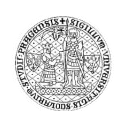
Laboratory of bacterial physiology
Group leader: Radovan Fišer
Dept. of Genetics and Microbiology, Charles University
Adenylate cyclase toxin of Bordetella pertussis (CyaA) :
CyaA targets CD11b/CD18 receptors of host myeloid cells and then catalyzes an uncontrolled cAMP
production together with forming hemolytic cation-selective channels. Various heterologous CD8,
as well as CD4 T-cell epitopes have been engineered into genetically detoxified CyaA and the
resulting toxoids were successfully used as vectors for delivery of inserted epitopes into
antigen-presenting cells. Using numerous CyaA mutants, we explore the mechanism of CyaA action,
its interference with cellular signalling and its endocytic pathways in host cell. Similarly as
in frames of the Project 1 we combine up-to-date fluorescence spectroscopic techniques with more
conventional biochemical and molecular biology approaches.
Bacilus subtilis: the role of the membrane proteins in cold adaptation and stress signalling.
After cold shock, Bacillus fluidizes its membrane by fatty acid desaturase Des. des expression
is controlled by the two-component DesK-DesR system with DesK as a putative membrane fluidity
sensor. To examine the purpose and effect of cold adaptation we integrate the data from various
levels - DesK signalling, membrane biophysical properties, membrane fatty acid composition and
others. Such integration allows us to correlate the protein signalling with changes in membrane
properties thus filling the common gap between biochemical and biophysical approaches.
Surfactin Production and the self-defence of producing Bacillus subtilis cells.
Surfactin is a lipopeptide antibiotic produced by Bacillus subtilis. It is formed of a cyclic heptapeptide interlinked with a β-hydroxy fatty acid comprising 12 – 16 carbon atoms. Surfactin interacts with the membrane and disturbs its integrity. This effect can explain a wide range of surfactin biological activities such as antibacterial, antiviral, antifungal, antimycoplasma, antiparasitic and anti-tumor. Surfactin as a powerful biosurfactant stimulates biofilm formation by its producer strains; however, inhibits the biofilm formation of pathogenic bacteria. All antibiotic-producing bacteria ensure their self-resistance by coding for various means of self-defense mechanisms. At the same time, the systematic use of antibiotics selects resistant variants of the susceptible target pathogens. As for the resistance mechanism, the antibiotic-producing strains are the most convenient source of information. We focuse on the nature of the surfactin resistance of the surfactin producer.
Collaboration
- Ing. Peter Šebo, PhD. - Institute of Microbiology, Czech Academy of Science, Prague (link)
- Prof. Diego de Mendoza, PhD – Institute of Molecular and Cell Biology, Rosario, Argentina (link)
- Prof. Kazimierz Strzalka, PhD – Faculty of Biochemistry, Biophysics and Biotechnology, Jagiellonian University, Krakow, Poland (link)
- Doc. RNDr. Petr Heřman, CSc., Doc. RNDr. Jaroslav Večeř, Faculty of Mathematics and Physics, Charles University, Prague (link)
- Doc. Martin Hof, DSc. J. Heyrovský Institute of Physical Chemistry, Czech Academy of Science, Prague (link)
- Doc. RNDr. Zažímalová, Eva, CSc., Institute of Experimental Botany, Czech Academy of Science, Prague (link)
- RNDr. Dana Elhottová, CSc. Institute of Soil Biology, Czech Academy of Science, České Budejovice (link)
National grants
- (2004-2008) Grant agency of the Czech Republic IAA5020406
- (2006-2010) Research Center LC 06034
- (2006-2010) Research Center LC 06066
- (2007-2013) Research Plan MSM0021620858
- (2012-2014) Grant agency of the Czech Republic GPP207/12/P890
- (2013-2015) Grant agency of the Czech Republic GP13-18051P
